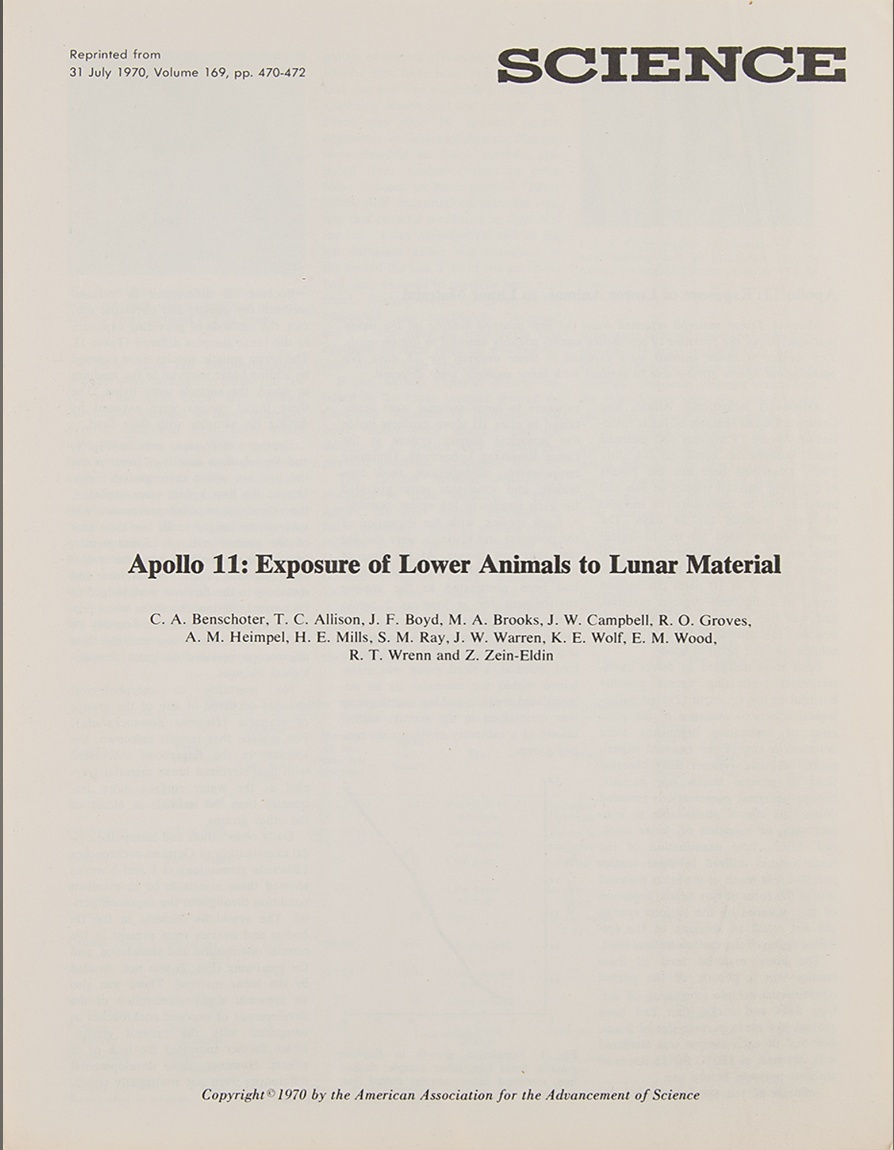Can the soil on the moon be eaten?What will happen if you eat it?
Author:High Energy Institute of the C Time:2022.08.30
The following article comes from WeChat public account: Science Courtyard, author Su Chengyu
The text in this article is 1714 words, and it is expected that the reading time is about 4 minutes
In June this year, the US auction house is auctioned a historical object. The protagonist is three cockroaches. The auction has not yet ended. So far, the price has soared to $ 33,000.

Three German cockroaches
Image source: Screenshot from RRAUCTION
what's going on? Why are three cockroaches so valuable?
It turned out that this was not an ordinary cockroach, but a cockroach of the moon.
After shopping, many people will jokingly say "I want to eat soil", but have you been curious about what taste of the moon in the moon? Has anyone eaten?
Public information shows that there are indeed several animals have eaten.
In 1969, when Amsterrand entered the moon for the first time by Apollo 11, he brought back 21.6 kg of moon samples when he returned to the earth, including 50 rocks, weathered soils on the surface of the moon, and 2 cm under the moon surface of 13 cm. Core sample.

Photos of the lunar space astronauts when collecting rock core samples
Image source: The u.S. National Archives
Lunar samples that are transported back to the earth are used for various scientific research. One of the uses you must never think of: feeding the moon to animals such as German cockroaches to see what they will do.
Maybe you want to say, is this experiment necessary?
It is really necessary. Considering the first landing of the moon, people know nothing about the situation on the surface of the moon, and it is unknown whether it contains a harmful substance to life. When members of Apollo 11 returned to the ground, they were isolated for 21 days (not familiar) to prevent them from carrying potential pathogenic substances back to the earth.
Yueyang was also isolated after arriving at the earth, but it was just in the vacuum chamber.
The scientist who is responsible for this experiment is Marion Brooks, a associate professor of insect science and a special consultant to NASA's resident insect school. She got a monthly soil of about 18 kg and experimented in the Lunar Receive Laboratory (LRL).

Marina Brooks' news reports when they got the moon soil
Image source: RRAUCTION
The experiments are not complicated. 10 different animals are raised in different breeding tanks, including eye insects, grass tapegers, vortexes, oysters, brown shrimp, German sipy, home flies, big waxy, blackhead fish, Canada, Canada, Canada, Canada, Canada Bottom (a small fish). From vertebrates to vertebrates. The reason for choosing these animals is because these animals are more common and easy to take care and process. The point is that scientists have done in -depth research on these animals, so scientists have pointed at all stages of their life history.
After grinding the moon soil into a particle with a diameter of about 2 microns, half of the sample disinfected for 16 hours at high temperature at 160 ° C. Two weeks before the formal test, all experimental animals were raised in a sterile organic glass cabin to allow them to adapt to the living environment first.
Each animal has two groups of experimental groups and two group control groups: one group in the experimental group eats the monthly soil after disinfection, and a group of uninterrupted monthly soils; in the control group, the other group feeds normal food, but it is being feeded by normal food, but it is being feeds on normal food, but it is being feeded. Breeding in the glass cabin, another group of feeding normal food, raised in a normal environment as the control group of the control group.

The moon soil after grinding
Image source: RRAUCTION

Record book for experiments
Image source: RRAUCTION
As a result, no experimental animal died in a consumption of the month, regardless of whether the moon soil was disinfected. Instead, the experiment officially started 6 days before the official start. During the adaptation of the environment, the black -headed fish was sprinkled into the fish tank because of the accidental scientists, which caused nearly half of the fish to die. Even if it survived, there were some residual sodium hypochlorite. Long -term lesions caused.
Do you think these animals can survive after the experiment? No, all animals have to dissect microclics, make more detailed physiological analysis to determine what impacts their bodies have.

Slice of the dyed tissue of that year
Image source: RRAUCTION
Brooks dissected experimental cockroaches and made organizational slices. Surprisingly, there is no pathological changes in cockroaches, and there is nothing wrong with it, and everything is normal. Obviously, the experiments did not find microorganisms in the moon.
The reason why Xiaoqiang is not dead is enough to surprise people, because although Yueyang is non -toxic, it seems that it looks harmful in terms of physical attributes. Because the soil of the moon is very different from the soil of the earth. The moon is the residue of the tiny meteorite impact. Because there is no air or water erosion, each dust maintains a sharp corner and looks like a broken glass.

Monthly Monthly Micro Mirror Vision made by NASA
Image source: IMPACT LAB
Even after grinding, the moon soil still retains sharp jagged edges. Imagine that there will be about the consequences of eating a broken glass. As a result, the cockroaches had nothing to do with the stomach and stomach after eating the "glass".

Cockaruy intestinal slices without wear evidence
Picture source: reference [1]

Small fish intestinal microstrip tissue sliced slices without pathological effects
Picture source: reference [1]
In the monthly soil sample brought back on the 12th and 13th Apollo, because the location of the monthly soil was different, Brooks repeated the same experiment, but the results were the same. On July 31, 1970, the results of this experiment were published in the "Science" magazine, entitled "Apollo 11: Exposure of LOWER Animals to Lunar Materials" Source: RRAUCTION

Today, more than fifty years later, this legendary study has come to the world again, but the form is no longer an experiment. Recently, a treasure in the Boston RR auction house is auction:
Auction project

Image source: RRAUCTION
Apollo 11th month of the month, including a small bottle of experimental cockroaches, tissue slices, three well -preserved German cockroaches experiment specimens, moon soils taken out of the gastrointestinal tract from cockroaches, and some historical materials related to the moon landing. In the control group and the experimental group, a total of 66 glass carriers in the control group are in the auction items.
The moon is not unusual, but the moon soil that eats into the belly of cockroaches becomes is really unique. Before I finished writing this article, there were 10 bids, and the bid was as high as US $ 30,000. The next bid price will reach $ 33,000, and the deadline for the bidding is June 24. We can wait and see its final price.
Experimental glass bottle

Image source: RRAUCTION
But ... I really curious about the taste of the moon soil, it is estimated that it will be a bit iron (there is iron in the moon soil).
references:
[1] https://www.science.org/doi/10.1126/science.169.3944.470
Htttps:://///rictions/ret association/lot-d archim/ 345933832-dol-ar-l-lides-mPTIN-vetounded-identive-testized-backItIntItIntItIbly-testIvically -Tate
This article is authorized to reprint from WeChat public account: Science College Author: Su Chengyu
Reprinted content only represents the author's point of view
It does not represent the high energy office of the Chinese Academy of Sciences
Edit: Jin Yan
- END -
Shijingshan exhibition area wonderful appearance of HICOOL 2022 Global Entrepreneur Summit

On August 26, the HICOOL 2022 Global Entrepreneur Summit opened grandly at the Chi...
Welcome the 20th National Congress to the Party | "My Struggle · Home Gome" short video is in the fiery!

In order to do a good job of welcoming the 20th major online propaganda of the par...